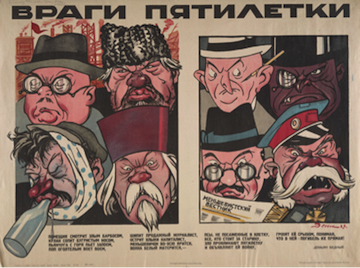This section covers the period of the first two Five Year Plans from 1928 to 1936. We will look at the Five Year Plans as a type of 'revolution from above'. We will be exploring the connections between the Five Year Plans and the Stalinist terror. Why did Stalin force through collectivization and what were its consequences for the Soviet peasantry? Who were the 'kulaks' and why did the Stalinist regime declare a war against them? Was the Ukrainian famine a genocide? What were the achievements of Stalinist industrialization in the Five Year Plans? How did it affect the living standards of the working class? And how important was the Gulag for the country's economic growth. The section contains extracts from my books, photographs and videos, suggestions for further reading. Register here to get information on accessing more materials including my responses to exam questions on these themes.

'Enemies of the Five Year Plan'
The Five Year Plan (1928-32) was a special type of 'revolution from above' - the accelerated transformation of the Soviet Union into a socialist industrial society by means of the state's coercive power to mobilize the masses for its goals. Read more...
Collectivization was the first 'great break' forced through by Stalin as part of the Five Year Plan. It destroyed a way of life that had developed over many centuries. Read more...
Peasants who spoke out against collectivization were threatened and harassed; many were expelled as 'kulaks' from their homes and driven out of the village. There were attacks on the church, which was regarded by the Bolsheviks as a source of potential opposition to collectivization. Read more...
Behind such statistics are countless human tragedies. Read more...
The men and women who carried out this brutal war against the peasantry were mostly soldiers and workers. Read more...
For the first years the collective farms were a dismal failure. Few had tractors to replace the horses slaughtered by the peasantry (human draught was used). Read more...
Stalin had a special distrust of the Ukrainian peasantry. He was more than capable of bearing grudges against entire nationalities, and of killing them in large numbers, as he would demonstrate during the Great Terror and the war. Read more...
Millions of peasants ran away from the collective farms. Peasants poured into the towns in search of work. Between 1928 and 1932 the urban population grew at the extraordinary rate of 50,000 people every week. Read more...
Statistically, through the Five Year Plans the Soviet Union achieved impressive rates of economic growth during the 1930s - a decade of depression in the capitalist states. Read more...
In 1928, the Soviet city dweller had on average 5.8 square metres of living space. Read more...
During the second Five Year Plan (1933-37) the government increased its investment in consumer industries, which had been starved of capital in the rush to build new factories and towns during 1928-32. Read more...
The rates of growth that Stalin had demanded in the Five Year Plan could not have been achieved without the use of forced labour. Read more...
These images tell us about the propaganda and reality of the achievements of the Five Year Plan Read more...
Here are some exam-like questions. Read more...
A recording of a lecture/class about these themes using primary documents. Read more...
A list of further reading. Read more...

